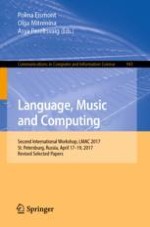2019 | Book
Language, Music and Computing
Second International Workshop, LMAC 2017, St. Petersburg, Russia, April 17–19, 2017, Revised Selected Papers
Editors: Dr. Polina Eismont, Olga Mitrenina, Asya Pereltsvaig
Publisher: Springer International Publishing
Book Series : Communications in Computer and Information Science
